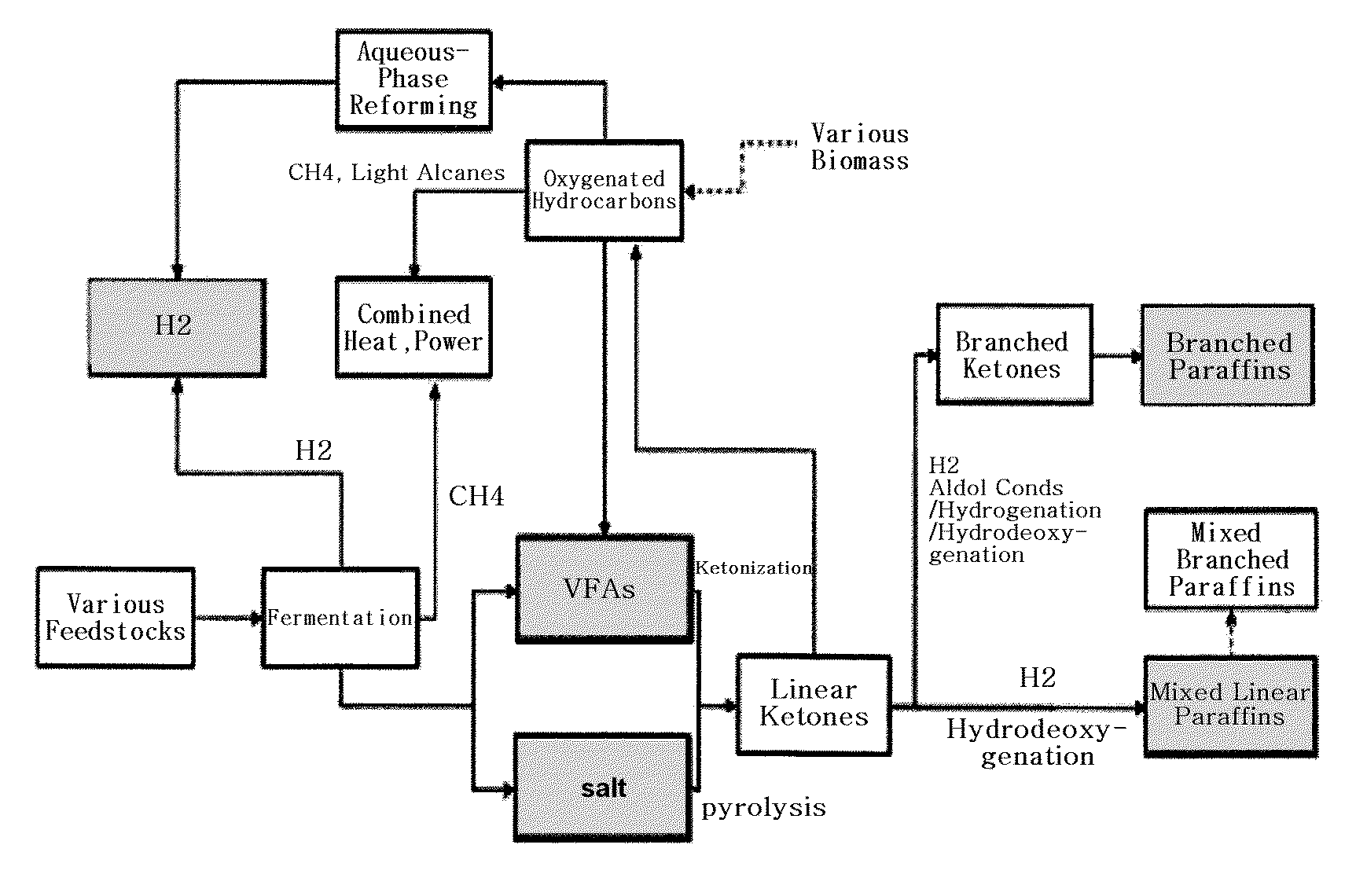Preparation method of transportation fuel or lubricating base oil using biomass
- Summary
- Abstract
- Description
- Claims
- Application Information
AI Technical Summary
Benefits of technology
Problems solved by technology
Method used
Image
Examples
example 1
[0109]A mixture of ketones was prepared from volatile fatty acids, derived from biomass, using a known technique [Journal of Molecular Catalysis A: Chemical 227 (2005) 231-239]. The composition of this ketone mixture is shown in Table 1 below. For the ketone mixture having the composition shown in Table 1, an experiment of preparing branched paraffinic hydrocarbons was carried out using a 0.2 wt % Pd / Nb2O5 catalyst. The 0.2 wt % Pd / Nb2O5 catalyst was prepared by loading Pd(NO3)2 (10 wt % Aldrich) onto niobic acid by an incipient wetness method, drying the loaded material at 393 K for 3 hours, and calcining the dried material at 533 K for 3 hours in an air atmosphere. The reaction was carried out using a high-pressure micro-reactor, and 6 g of the 0.2 wt % Pd / Nb2O5 catalyst prepared by the above was used in the experiment. The reduction of the catalyst was performed by heating it to 723 K at a rate of 0.5° C. / min at a hydrogen flow rate of 200 sccm, maintaining it at that temperature...
example 2
[0111]For the ketone mixture having the composition shown in Table 1, an experiment of preparing branched paraffinic hydrocarbons was carried out using a Cu / Mg10Al7Ox catalyst. The Cu / Mg10Al7Ox catalyst was prepared by mixing Cu, Mg and Al nitrate precursors at a molar ratio of 1:10:7 and co-precipitating the mixture at pH of 10 using a mixed solution of KOH and K2CO3. The prepared cake was stirred at 338 K while distilled water was added dropwise thereto, and then allowed to stand for 2 hours, and the precipitate was filtered and washed. The washed material was dried at 393 K for a sufficient time and calcined at 773 K in an air atmosphere for a sufficient time. For the reduction of the catalyst, 6 g of the catalyst was introduced in a high-pressure micro-reactor in which it was reduced in-situ at 573 K at a hydrogen flow rate of 200 sccm for 1 hour. The reaction for preparing branched paraffinic compounds was carried out under the same conditions as Example 1. After the reaction, ...
example 3
[0113]For the ketone mixture having the composition shown in Table 1, an experiment of preparing branched paraffins was carried out using a 0.2 wt % Pd / CeZrOx catalyst. To prepare the 0.2 wt % Pd / CeZrOx catalyst, the CeZrOx support was prepared in the following manner. Ce(No3)36H2O and ZrO(NO3)2 were mixed at a ratio of 1:1 and co-precipitated for 65 hours while the pH was kept of 10 with NH4OH. The precipitate was filtered, washed, dried at 383 K for a sufficient time and then calcined at 723 K for 2 hours. To reduce the catalyst, 6 g of the catalyst was introduced in a high-pressure micro-reactor in which it was reduced by heating it to 623 K at a rate of 0.5° C. / min and maintaining it at a hydrogen flow rate of 200 sccm for 2 hours. The reaction for preparing branched paraffinic compounds was carried out under the same conditions as Example 1. After the reaction, the conversion of each of the mixed ketones was analyzed by GC, and the results of the analysis are shown in Table 6 b...
PUM
| Property | Measurement | Unit |
|---|---|---|
| Temperature | aaaaa | aaaaa |
| Pressure | aaaaa | aaaaa |
| Temperature | aaaaa | aaaaa |
Abstract
Description
Claims
Application Information
 Login to View More
Login to View More - R&D
- Intellectual Property
- Life Sciences
- Materials
- Tech Scout
- Unparalleled Data Quality
- Higher Quality Content
- 60% Fewer Hallucinations
Browse by: Latest US Patents, China's latest patents, Technical Efficacy Thesaurus, Application Domain, Technology Topic, Popular Technical Reports.
© 2025 PatSnap. All rights reserved.Legal|Privacy policy|Modern Slavery Act Transparency Statement|Sitemap|About US| Contact US: help@patsnap.com



